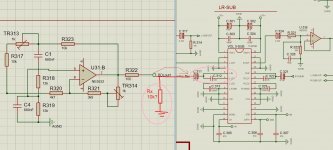To use or not to use..
Here is the connection bettwen two modules (attached).
Opamp tone correction module, vol control module (tc9459).
- Do I need Rx (lets say 10k) to set the input impedance of the volume control?
There is only a decouplling cap at the digipot input.
Modules are connected with ~5 cm shielded cable.
I would like to omit ouput cap and resistor to ground in the first opamp module.
Here is the connection bettwen two modules (attached).
Opamp tone correction module, vol control module (tc9459).
- Do I need Rx (lets say 10k) to set the input impedance of the volume control?
There is only a decouplling cap at the digipot input.
Modules are connected with ~5 cm shielded cable.
I would like to omit ouput cap and resistor to ground in the first opamp module.
Attachments
Decoupling caps hang from power lines.
Coupling caps carry signal from one stage to another.
You do not need that 10k resistor. Why did you add it?
Coupling caps carry signal from one stage to another.
You do not need that 10k resistor. Why did you add it?
The impedance at that point is 100 ohms, since the opamp output is a voltage source (zero source impedance).- Do I need Rx (lets say 10k) to set the input impedance of the volume control?
Adding the 10k will reduce the 100 ohms to 99 ohms...
Decoupling caps hang from power lines.
Coupling caps carry signal from one stage to another.
You do not need that 10k resistor. Why did you add it?
I dont know if needed... Seems it does not need it.
In general, the digipot does not amplify.
If we have an input of an amplifier, the resistor to ground sets input impedance.
The lower possible input impedance for the particular application, the less noise?
The 10k will reduce the open-circuit noise (when nothing is plugged in), yes. In fact if you know you have a 100 ohm source impedance when connected you can reduce the 10k to 2k2 or so for even quieter noise floor with the input unconnected, but 10k is a reasonable value.
It basically does nothing once that low impedance source is connected, but will reduce thumps on plugging in and noise/hiss when unplugged.
It basically does nothing once that low impedance source is connected, but will reduce thumps on plugging in and noise/hiss when unplugged.
A shunt resistor will "never" improve signal to noise ratio. It usually reduces signal just as much as it reduces noise.
Hiss (noise) should not be an issue here. The signal should already be pre-amplified far above noise level. It "has" to be, because the pot attenuation makes a smaller signal more susceptible to noise.
Hiss (noise) should not be an issue here. The signal should already be pre-amplified far above noise level. It "has" to be, because the pot attenuation makes a smaller signal more susceptible to noise.
"A shunt resistor will "never" improve signal to noise ratio."
Sure it will---Mark is right on. If you UNPLUG the source without the 10K resistor, you effectively have a 1000000M source impedance and thus a lot more noise than you will have WITH the 10K resistor. Once the connection is made, the 10 K resistor does nothing.
Sure it will---Mark is right on. If you UNPLUG the source without the 10K resistor, you effectively have a 1000000M source impedance and thus a lot more noise than you will have WITH the 10K resistor. Once the connection is made, the 10 K resistor does nothing.
Last edited:
This happens without even unplugging in modern mp3 players and the like - when the circuit auto-shutdowns after playing it removes power to the internal headphone jack amplifier (the player is still on, its just saving battery while you decide what to play next), making it go high-Z, often causing very audible hiss if the receiving amp doesn't have a low value resistor load (which of course is fine for a headphone jack).
"A shunt resistor will "never" improve signal to noise ratio."
... If you UNPLUG the source .....
Then you have no signal. S/N is exactly zero.
My bad. Of course the RATIO is zero. But the noise isn't. And that is the point of having the 10K shunt resistor in the first place.
This happens without even unplugging in modern mp3 players and the like - when the circuit auto-shutdowns after playing it removes power to the internal headphone jack amplifier (the player is still on, its just saving battery while you decide what to play next), making it go high-Z, often causing very audible hiss if the receiving amp doesn't have a low value resistor load (which of course is fine for a headphone jack).
Yes, that is VERY annoying.
Depending on your program, sometimes output mutes between Albums/directories or even YT videos, *specially* when they use that ANNOYING "feature" 😡 of interrupting a long playlist or even a full Album (we are talking less than 10 songs here) to ask you: "do you want to keep listening? Please confirm" AAAARRRRRGGGGHHHH!!!! 😡😡😡
Also many Phones will MUTE headphone output if they do not detect their presence, so line out to an amp does not work.
They want some lowish DCR at those jacks, so I solve BOTH problems by wiring a 100 ohm 1/8" resistor inside the plug, from Hot to Ground.
My bad. Of course the RATIO is zero. But the noise isn't. And that is the point of having the 10K shunt resistor in the first place.
Is it the same, if the stage is buffer (gain 1) or the digipot?
Or then it really does not matter if we have/ dont have a shunt resistor (gain 1)
- Home
- Source & Line
- Analog Line Level
- input Z resistor to ground
